

Roman Symbols. Chapter 18 - Logotypes and Branding. The word logo is rooted in the Greek word lógos meaning a word, saying, speech, discourse, thought, proportion, and ratio.

In the world of graphic design a logo must represent all these concepts. Logo is associated with logotype which is defined as; a graphic representation or symbol of a company name, and trademark, which is uniquely designed for ready recognition. Any study of logos, need to look at it from the perspective of both historical evolution of graphic design and, of course, an overall marketing strategy in which a logotype would be presented as a symbol or a brand to distinguish a particular product among its many rivals in the marketplace.
In economics jargon this is called Product Differentiation. Of course, many nonprofit humanitarian, cultural and political entities also use logos to convey a particular image of themselves. The flag of the Olympic Games has been designed by Pierre de Coubertin. Early logos, 1910-13. Fasces. An unusual fasces image, with the axe on the outside of the bundle of rods.
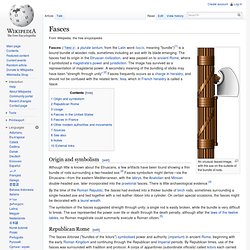
Origin and symbolism[edit] Although little is known about the Etruscans, a few artifacts have been found showing a thin bundle of rods surrounding a two-headed axe.[3] Fasces-symbolism might derive—via the Etruscans—from the eastern Mediterranean, with the labrys, the Anatolian and Minoan double-headed axe, later incorporated into the praetorial fasces. There is little archaeological evidence.[4] By the time of the Roman Republic, the fasces had evolved into a thicker bundle of birch rods, sometimes surrounding a single-headed axe and tied together with a red leather ribbon into a cylinder.
On certain special occasions, the fasces might be decorated with a laurel wreath. Kaducej. Moderna, stilizovana verzija Kaducejasimbola bogova Hermesa i Merkura Simbolika[уреди] [уреди] Pogrešna upotreba u medicini[уреди] Zbog svoje sličnosti sa Eskulapovim štapom, kaducej je često greškom uziman kao simbol medicine.
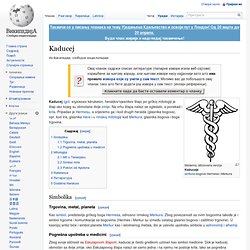
Dok je kaducej obmotan sa dvije zmije, oko Eskulapovog štapa nalazi se samo jedna i na njemu ne postoje krila. Уџат око. Уцат око, касније названо око Хоруса Уџат око (Wedžat oko), или Око Хоруса, некад и Око Ра, је староегипатски Фунерарни симбол, заштите и краљевске моћи.
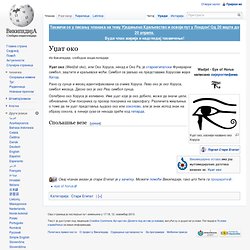
Симбол се јављао на представама Хорусове мајке Хатор. Рано су сунце и месец идентификовани са очима Хоруса. Лево око је око Хоруса, симбол месеца. Десно око је око Реа, симбол сунца. Озлеђено око Хоруса је изливено. Eye of horus. Анк. Египатски анк Анк (лат. crux ansata, крст са дршком, симбол ☥) је египатски хијероглиф који има значење „вечни живот“.
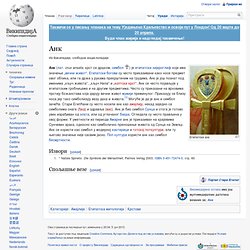
Египатски богови су често приказивани како носе предмет овог облика, или га држе у рукама прекрштеним на грудима. Анк је још познат под именима „кључ живота“, „кључ Нила“ и „коптски крст“. Анк се често појављује у египатским гробницама и на другим предметима. Често су приказани на врховима прстију божанстава која дарују вечни живот мумији преминулог. Извори[уреди] Спољашње везе[уреди] Labarum. Labarum of Constantine I, displaying the "Chi-Rho" symbol above.
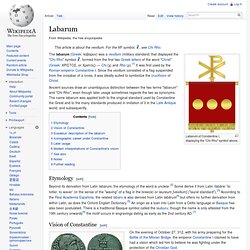
Ancient sources draw an unambiguous distinction between the two terms "labarum" and "Chi-Rho", even though later usage sometimes regards the two as synonyms. The name labarum was applied both to the original standard used by Constantine the Great and to the many standards produced in imitation of it in the Late Antique world, and subsequently. Etymology[edit] Byzantine flags and insignia. The double-headed Byzantine Eagle.
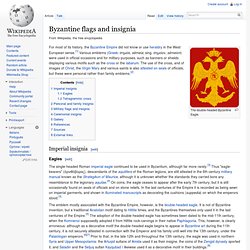
For most of its history, the Byzantine Empire did not know or use heraldry in the West European sense.[1] Various emblems (Greek: σημεία, sēmeia; sing. σημείον, sēmeion) were used in official occasions and for military purposes, such as banners or shields displaying various motifs such as the cross or the labarum. The use of the cross, and of images of Christ, the Virgin Mary and various saints is also attested on seals of officials, but these were personal rather than family emblems.[2] Imperial insignia[edit] Eagles[edit] Ideogram. "No Dogs!
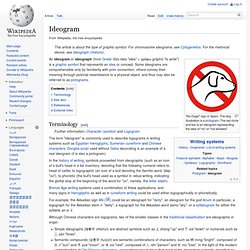
" sign in Spain. The dog illustration is a pictogram. The red circle and bar is an ideogram representing the idea of "no" or "not allowed". An ideogram or ideograph (from Greek ἰδέα idéa "idea" + γράφω gráphō "to write") is a graphic symbol that represents an idea or concept. Some ideograms are comprehensible only by familiarity with prior convention; others convey their meaning through pictorial resemblance to a physical object, and thus may also be referred to as pictograms. Terminology[edit] The term "ideogram" is commonly used to describe logograms in writing systems such as Egyptian hieroglyphs, Sumerian cuneiform and Chinese characters.
Bronze Age writing systems used a combination of these applications, and many signs in hieroglyphic as well as in cuneiform writing could be used either logographically or phonetically. Serb heraldry. The use of heraldry in Serbia or by Serbs is used by government bodies, subdivisions of the national government, organizations, corporations and by families.
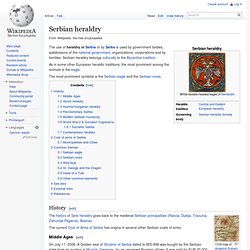
Serbian heraldry belongs culturally to the Byzantine tradition. The most prominent symbols is the Serbian eagle and the Serbian cross. Heraldry. Byzantine flags and insignia.